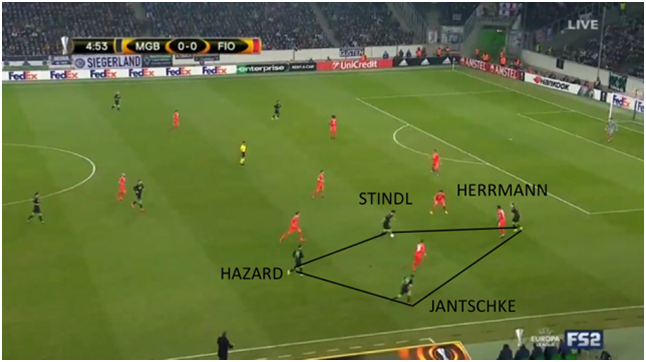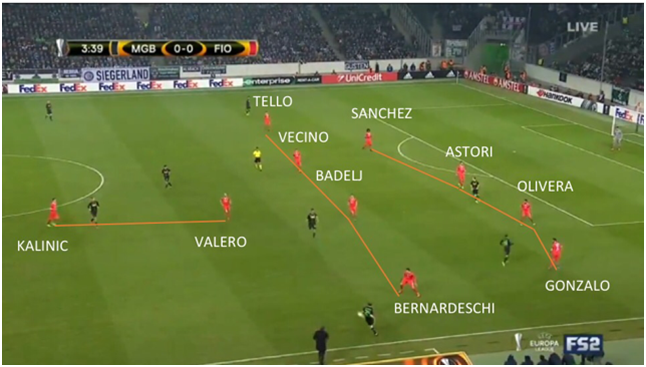Charles Onwuakpa writes a detailed tactical analysis of the UEFA Europa League match that ended Gladbach 0-1 Fiorentina.
The visitors grabbed an all important away win in the first leg of the Europa League’s final stage, thanks to a moment of brilliance from their number 10, in what was a generally poor performance, as they held on defensively and eventually had luck on their side, after the hosts had created a couple of excellent chances but lacked in the final third.
Line Ups
Paulo Sousa made a couple of changes in the Viola’s 3-4-2-1 formation which saw them win 3-0 last Saturday against Udinese: Maxi Olivera and Cristian Tello returned to the starting XI as replacements for Federico Chiesa and Milic, while Croatian international Nikola Kalinic was back in full form upfront after some injury woes.
On the other hand, Dieter Hecking picked a 4-4-2 formation, with Lars Stindl and Thorgan Hazard upfront and the duo Fabian Johnson-Patrick Herrmann as wingers. In the centre of the park, midfield sensation Mahmoud Dahoud partnered German international Christoph Kramer.

Made using TacticalPad
Fiorentina’s early problems in buildup
In the first two-three minutes of the game, it looked like the visitors would have settled well in the match with the aim of creating chances through their quadrilateral midfield and positional play, but the hosts proved them wrong. During their opponents’ first phase of buildup, Gladbach sat in their own midfield with a very compact 4-4-2: Stindl and Hazard worked in pairs to prevent both Badelj and Vecino from receiving the ball and were very efficient at it. The Italian side’s ball circulation became therefore predictable and mainly sideways, allowing the Germans to press with intensity and win it back. Fiorentina tried to play some long balls towards the flanks, but Borussia protected the width of the pitch superbly as they gained momentum and dominated the first half.

Borussia’s fluid buildup
The hosts took a few minutes to change the tempo of the game in their favour, but then they finally switched gear: in the first phase buildup, Kramer dropped alongside the two centrebacks to guarantee a 3 vs 2 situation against Kalinic and Valero, although it was quite easy for both defenders to advance with the ball at their feet. They initially attacked on the right wing, by using passing chains and quick combinations in pockets of space. Dahoud and Stindl played key roles in the game, as they were always on the move in the centre of the park to offer nearby, forward passing solutions and link up both wings quickly for fast positional attacks, as the home side shifted to a very flexible 3-4-3 formation. While Johnson and Hazard tried to drag away defenders and open up central spaces with horizontal movements, Hermann caused more than a problem for Olivera, as the Penarol-based left-back struggled to deal with the winger’s runs at the back posts during crosses.


Fiorentina’s midfield collapsed during quite a few defensive transitions as Fabian Johnson and Lars Stindl missed two glorious chances to get the lead: the American hit the post while the home side captain skyrocketed what was basically an open play penalty in the space of two minutes. Patrick Hermann had previously missed a good chance by kicking the ball towards Tatarusanu’s arm after a lovely one-two with Thorgan Hazard in the penalty box: the Germans’ number 7 found himself in the right place at the right time in a couple of situations, but lacked of composure and killer instinct to give the home side a much deserved lead. Their numerous errors in the end were punished by a moment of brilliance by Federico Bernardeschi.
Sousa’s men gain courage
Fiorentina sat too deep and never pressed in an organised way, as Badelj and Vecino were cut out of positions by some laser passes from Christensen and Dahoud. They were also too centre-minded and became extremely vulnerable for the Germans’ numerous overloads. Target man Nikola Kalinic had a very difficult game and didn’t see as much of the ball as he would have loved to.
He succumbed in aerial duels under the force of Vestergaard, who was mainly his direct marker. The visitors switched to a flat 4-4-2 with Bernardeschi dropping to the left wing and Borja Valero acting as a second striker. As said before, the Italian side didn’t press in a compact and organised way, especially in the first half. Sousa noticed this and invited his team to press high up the pitch as a whole unit, therefore reduce the enormous pressure that they were suffering due to their reluctance in disturbing their opponents’ buildup, but rather keeping their positions and defending for their lives.

Fortunately for them, the Viola got back in the game and finally had their first shot on target in the 36th minute, courtesy of Matias Vecino. Gladbach conceded possession after missing some clear-cut chances and decided to unleash their pace in counterattacks. This was a bad idea though as Bernardeschi was finally able to find pockets of space and suffered a foul about 25 metres from goal. The 23 year old Italian lit up Borussia Park with a lovely set piece, which went straight to the far top corner and out of Sommer’s reach, just before the end of the first half. Bernardeschi wasn’t able to tuck into half-spaces as he would have liked to: the young trequartista had a bad passing accuracy rate (68%), but he worked hard and tried to make as much of a defensive contribution as possible, eventually scoring a pure gem with his deadly left foot.
Catenaccio all’italiana
Galvanised by the half time lead, the Italians became a little bit more adventurous and proactive, as Borja Valero nearly doubled their advantage after an hour of play after some good link up play on the right hand side between Kalinic and Tello.
But soon Hecking’s side regained possession and tried to dominate the game once again with their patient but deadly buildup; this time though Fiorentina defended much better, especially Milan Badelj, whose second half drastically improved: the former Hamburg man won 3 tackles, completed 4 dribbles and made 9 clearances, as the Italians were happy to knock the ball forward in a typical catenaccio style.
Substitutions
Fiorentina’s subs Kouma Babacar and Cristoforo had to help the team defend through the centre and the wings, as Gladbach’s chances eventually reduced. Hecking then decided to go for an all-attack 3-4-3 system in the final twenty-five minutes, with striker Josip Drmic coming off the bench for Jantschke. Sousa took countermeasures and sent on Nenad Tomovic for Tello in what became an ultra-defensive 5-3-2 formation in the final minutes. Apart from a couple of tricky crosses, Gladbach soon became frustrated for the resilient display showcased by the visitors, who were able to kill the high tempo of the encounter and earn a hard-fought win.
Conclusion
It was an entertaining game and Borussia will be furious to have lost it. On the other hand, Sousa’s team didn’t live up to its expectations, as the Italians were slow and predictable in buildup and needed a moment of individual brilliance to get the first leg advantage. The second leg promises to be even more exciting: the Viola, who are still unbeaten on the road in Europe, haven’t lost a single game this season at the Franchi, whereas Mönchengladbach have been in good form lately. Both teams can definitely improve, but the visitors will probably be ok with the result, as San Siro awaits them on Monday night’s big clash against AC Milan in Serie A: a crucial game as both are fighting for a European spot. In the meantime, the Germans will be looking forward to bounce back this weekend against second-placed Leipzig in the Bundesliga.
Read all our tactical analyses here























































